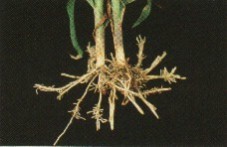Herbicide Symptom Key
I. Herbicide applied exclusively to the soil - injury appeared as the weed/crop emerged or did not emerge
Symptoms:
Cell division inhibitors - General symptoms include stunted plants with abnormally thick, short roots with swelled root tips. Injured plants may not emerge at all or do not fully emerge. Grass shoots are short and thick and may appear red or purple in color. Broadleaf plants may have swollen and cracked hypocotyls. Tolerant species, typically large seeded species, emerge and are temporarily stunted due to slow root development.
Shoot cell division/cell elongation inhibitors resulting in shoot malformation - Symptoms are stunted plants with twisted shoots and dark green leaves. Seedlings fail to emerge or exhibit poor emergence from the soil. Grasses may fail to emerge from the coleoptile properly or grass leaves may not properly unfurl. Broadleaves may have crinkled or puckered leaves or a shortened midvein, or leaf buds may not open.
Other cell division abnormalities - symptoms are a lack of weed/sensitive crop emergence
(No photo available)
Caroteniod pigment inhibitors - plants emerge a pale green but tissue rapidly turns chlorotic and white, and eventually necrotic; plants are stunted. Caroteniod pigment inhibitors are absorbed by roots and translocated in the xylem along with water to leaves.
Issued in furtherance of Cooperative Extension work, acts of May 8 and June 30, 1914, in cooperation with the U.S. Department of Agriculture, James A. Christenson, Director Cooperative Extension, College of Agriculture, The University of Arizona.
The University of Arizona is an equal opportunity, affirmative action institution. The University does not discriminate on the basis of race, color, religion, sex, national origin, age, disability, veteran status, or sexual orientation in its programs and activities.
Because labels are subject to frequent change, always consult the label attached to the product before using any pesticide. The user must assume responsibility for proper application and for residues on crops as well as for damage or injury caused by pesticides, whether to crop, person or property.
Any products, services, or organizations that are
mentioned, shown, or indirectly implied in this web document do not imply
endorsement by The University of Arizona.
Erin Taylor, etaylor@cals.arizona.edu Extension Agent, Field & Veg Crops
William B. McCloskey, wmcclosk@ag.arizona.edu Extension Weed Specialist
College of Agriculture, The University of Arizona, Tucson, AZ.
Material written June 2003.
Key home page | Soil Applied | Foliar Applied
Cotton Weed Pubs | Forage Weed Pubs | Grain Weed Pubs | Vegetable Weed Pubs
Home | Weeds Home Page | Citrus Weeds
document located at: http://cals.arizona.edu/crops/weeds/key/partone.html
Copyright © 2001 University of Arizona,
College of Agriculture and Life Sciences
webmaster: jsjones@ag.arizona.edu


